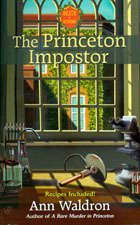Sun 11 Mar 2007
Review: ANN WALDRON – The Princeton Imposter
Posted by Steve under Authors , Characters , ReviewsNo Comments
ANN WALDRON – The Princeton Imposter
Berkley, paperback original. First printing, January 2007
This is the fifth mystery novel from Ann Waldron’s pen, all of them in her McLeod Dulaney series. According to her website, she’s also the author of a number of well-regarded biographies and a number of children’s books, both fiction and non.
Like her fictional character – who’s female, by the way, which I’d better add in case you’re seeing her name for the first time and you’re not sure – Ann Waldron has been a journalist and writer her entire working career. For the record, here’s the list of all five of her mysteries, each of them taking place in and around Princeton University:
Death of a Princeton President. Berkley, pbo; February 2004.
Unholy Death in Princeton. Berkley, pbo; March 2005.
A Rare Murder in Princeton. Berkley, pbo; April 2006.
The Princeton Imposter. Berkley, pbo; January 2007.
I imagine you see the pattern here as well as I do. Whenever McLeod Dulaney is on campus, that’s the semester you should be heading abroad or taking a sabbatical. McLeod herself is not a full-time faculty member; she’s an award-winning journalist and a visiting professor from Florida who teaches one course in journalism a year at Princeton University. Not so coincidentally, that is precisely where the author herself began working more than 30 years ago.

Which is why the love of the school and campus – the students, the staff and the professors, the legend and the lore – is as much of a key ingredient of the story as it is. The “imposter” in the title is Greg Pierre, one of McLeod’s better students, an older student who managed to gain admission to the university under an assumed name and falsified credentials. It seems that he’d previously been arrested in Wyoming – on false charges he says – and in order to come to New Jersey, he had to break parole.
And soon after his arrest the fellow who turned him in is found murdered, a grad student in the chemistry department who (as it turns out) was highly unliked for a number of reasons, which makes for a long list of suspects. But when McLeod’s good friend in the police department, Lt. Nick Perry, seems to settle in on Pierre as the most likely of them – no surprise there – she thinks otherwise, and she sets out to prove it.
Waldron writes in short, crisp, no-nonsense sentences, and McLeod Dulaney, in a number of ways her fictional alter ego, perhaps, conducts her investigation in very much the same style. Investigative journalists, by the nature of their profession, soon acquire the knack of asking questions in a way that people answering them sometimes reveal more than they intended, or if not, they quickly find another line of work. McLeod doesn’t need to worry on that account.
On the other hand, while she does a whole lot of detecting, she does not do a whole lot of deducting. (One does not necessarily imply the other.) First she decides that this student is the guilty party, then that professor, and as a result, she always seems to be one step behind – she doesn’t ever seem to catch up. Which of course leads to the ending. In my book, it comes as a letdown, leaving the reader (me) feel caught standing on the wrong foot at the wrong time, or should that be the right time? It also feels cluttered — more for dramatic effect, I thought, than for any other reason.
Overall, then? Here’s a book that’s well worth reading for anyone who’s fond of mysteries which either take place in academic locales or rank well above average in the writing department, or both. You can take my other caveat for whatever it might be worth.